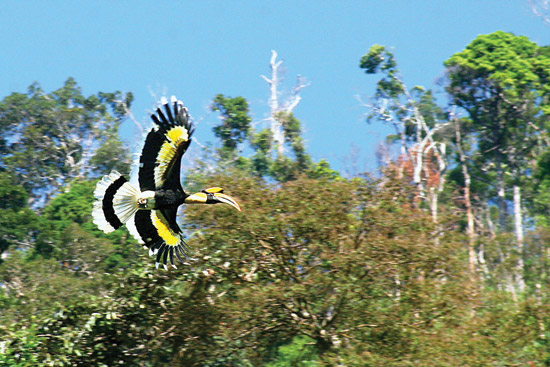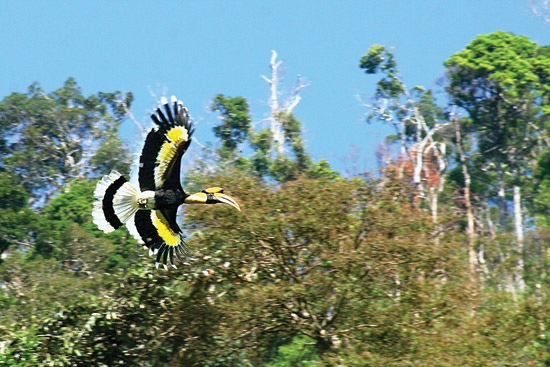(No.2, Vol.2 Feb 2012 Vietnam Heritage Magazine)
The great hornbill (Buceros bicornis) is the biggest member of the Bucerotidae family. It lives in semitropical forests in India, Southeast Asia and southern China. It is a big bird with a massive and colourful bill. In Vietnamese it is called chim h?ng hoàng or chim mo? s??ng, (chim = bird, h?ng = pink, hoàng = regal, m? = beak, s?ng = horn).
The bird is 95-120 cm long, with a 180 cm wingspan and weighs 3-4 kilograms. It often sings loudly in the early morning and in the evening and can be heard for kilometres. The sounds of its wings tearing the wind can be heard for hundreds of metres.
The great hornbill finds food in forest canopies and rarely touches the ground. Sometimes when it needs to communicate with monkeys, it swoops. It always signals monkeys to warn them of danger.

The great hornbill is predominantly frugivorous and has been called the perfect ‘reforestation activist’, because it eats fruits then travels and disperses seeds. Seeds that have been through the great hornbill’s gut grow into trees particularly easily.
The birds also eat small animals, birds, lizards, snakes and insects. They can even eat strychnine fruit, a poison fruit that almost no bird dares to taste. Its bill is long compared with its tongue, so it seems a little clumsy in feeding. The first two of the great hornbill’s vertebrae are fused, making the bill look big, cumbersome and slow but it can work strongly and actively when it is getting tiny fruits or catching agile small snakes and insects.
When the great hornbill finds a satisfying hollow, it makes its home there for the rest of its life. The tree it chooses must belong to the highest group of trees in the forest. Normally, the tree is above 50 metres tall and has natural spaces matching the great hornbills’ requirements. The hollows must have two storeys, one for laying eggs and the other a hide-out. Every year, they use their bills to carve to enlarge the nest, so it becomes more and more like a real house. The sound of carving is like the sound of nails being driven. It can be heard clearly from a hundred metres away.
Ten days before laying eggs, the female bird creeps into the nest and imprisons itself to clean and mend.
Then the female bird, from inside the nest, with the help of the male bird outside, begins to close the nest with a wall of bark, faeces and fruit powder mixed with a liquid from their bill. Usually, the wall is completed in one to several days. A small space is left for the male to feed the female daily.
The great hornbill often lays two eggs, normally hatching one chick. During 40 days of incubation, the female bird goes through a period of complete feather-changing. The male bird takes the responsibility of feeding its mate and chicks, which have to stay inside the nest. It finds and swallows fruits down to its stomach, then flies back to the nest and shakes itself so that the fruits will come out to its bill and it can skilfully give one piece at a time to the female bird. Because of this trait, male great hornbills are called ‘the number one dad in nature’.
After the female bird is ready to come out, together with the male bird it finds food to feed the chicks until they are old enough for an independent life outside the nest.
The great hornbill is mono-gamous for its whole life and it can live to more than 60.
The male bird is always 20 per cent bigger than the female bird in both weight and length. Their coats are similar and their basic colours are black, white, brown and yellow. Their bills are always yellow with some pink on top.
In Vietnam, theoretically, the great hornbill lives all over the country. It is in the Vietnam Red Data Book and the IUCN Red List. Exploitation in any form is forbidden. Great hornbills are in reality being over-hunted, so there are only a few left in nature.n
,,
,,

